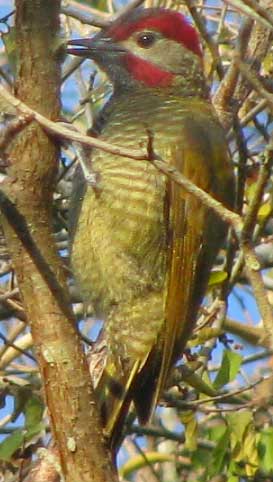Excerpts from Jim Conrad's
Naturalist Newsletter
from the March 14, 2010 Newsletter issued from Hacienda Chichen Resort beside Chichén Itzá Ruins, central Yucatán, MÉXICO; limestone bedrock, elevation ~39m (~128ft), ~N20.676°, ~W88.569°
GOLDEN-OLIVE WOODPECKER
We do not lack for woodpeckers here; they're among our most common birds. Thing is, nearly all of them are Golden-fronted Woodpeckers, which are similar to North America's Red-bellied species, as you can see at www.backyardnature.net/yucatan/wp-g-f.htm.
Though around Hacienda Chichen we're within the distribution area of seven woodpecker species, and just beyond the limits of two more, those other species are so infrequently seen that whenever you spot a woodpecker here that is NOT a Golden-fronted, it's worth noting. Therefore, the other day I was tickled when the one appearing below showed up.

This new woodpecker lacks the Golden-fronted's striking black and white barring, has a red moustache which the Golden-fronted lacks, and is generally a bronzy hue overall while the Golden-fronted is black and white, with red on the head and, sometimes, belly. What's in the picture is the Golden-olive Woodpecker, PICULUS RUBIGINOSUS. The genus Piculus, not appearing in North America, specializes in humid tropical forests and is noted for being heard more than seen, for usually they remain relatively inactive and are easily overlooked.
The bird I saw gave the impression of being new in the neighborhood, maybe just passing through. He busily flitted from one branch to another, pecking on wood that sounded solid to me, thus wormless, and wood a woodpecker knowing his territory wouldn't bother to tap on. He also seemed a little nervous. Well, spring is coming, the Equinox is approaching, and many birds' hormones are starting to stir, making them seem a little friskier than usual, so maybe that was his situation.
Golden-olive Woodpeckers reside from Mexico south to Peru and northern Argentina.